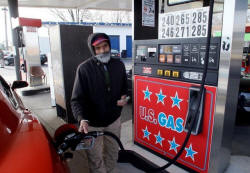|
 Stubborn
oversupply through 2016 to curb oil price recovery: poll Stubborn
oversupply through 2016 to curb oil price recovery: poll
 Send a link to a friend
Send a link to a friend
[January 04, 2016]
By Vijaykumar Vedala
(Reuters) - Crude oil prices are unlikely
to rally much in 2016 as subdued demand growth looks unable to absorb
rising supply from the likes of Iran and Iraq, even though non-OPEC
output is expected to moderate, a Reuters poll showed on Monday.
|
|
 The average 2016 price for benchmark North Sea Brent crude futures
was forecast at $52.52 a barrel, $5.43 below the previous month's
poll, according to the survey of 20 analysts. The average 2016 price for benchmark North Sea Brent crude futures
was forecast at $52.52 a barrel, $5.43 below the previous month's
poll, according to the survey of 20 analysts.
This is the seventh consecutive monthly Reuters poll in which
analysts have cut their price.
In May, analysts forecast Brent to average $70.90 in 2016, but have
been reducing their outlook ever since.
Thirteen of the 18 respondents who participated in both the November
poll and the most recent survey, conducted in December, cut their
average 2016 price forecasts for Brent futures, which averaged
$53.79 in 2015.
Oil prices have been hovering around 11-year lows after falling to
their lowest since mid-2004 in late December, as near-record-high
production looks set to feed a global surplus.

"Even if non-OPEC production (USA, Brazil, Canada) declines by
0.6-0.8 million barrels per day (bpd) in 2016, an increase in
production from Iran and Iraq will continue to keep the market in an
oversupply situation in 2016," CRISIL Research director Rahul
Prithiani said.
Analysts said high inventory levels could persist well into 2017 as
it may take a while to clear the overhang in unwanted stocks.
"Demand growth will be impacted on account of the slowdown in
Chinese demand growth, increase in efficiencies in the OECD (Organisation
for Economic Cooperation and Development) countries, substitution
from natural gas and removal of subsidies in developing countries,"
Prithiani said.
Analysts were not unanimous over whether lower prices would force
the Organization of the Petroleum Exporting Countries (OPEC) to cut
production.
[to top of second column] |

A few believed OPEC might take some action if prices fell below $30,
while others said there was no sense in the group cutting production
unless demand collapsed significantly.
"The only scenario in which it makes sense for OPEC to cut
production would be a collapse in demand, so a hard landing in China
could potentially trigger such a move," Capital Economics
commodities analyst Thomas Pugh said.
Analysts saw U.S. crude futures averaging $49.75 a barrel in 2016,
compared with $53.73 forecast in November. West Texas Intermediate
crude futures averaged $48.90 in 2015.
ABN Amro had the highest 2016 forecast for Brent at $65 a barrel,
while Nomisma Energia had the lowest at $38.08.
(Reporting by Vijaykumar Vedala in Bengaluru; Additional reporting
by Koustav Samanta and Swati Verma; Editing by Dale Hudson)
[© 2016 Thomson Reuters. All rights
reserved.] Copyright 2016 Reuters. All rights reserved. This material may not be published,
broadcast, rewritten or redistributed.
 |